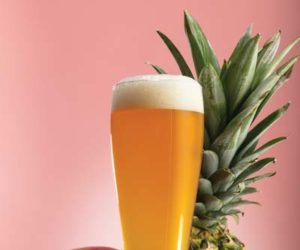Hop Creep, Hop Utilization, and a Different Approach to Beer Judging
Q I have a question about some beers that seem really dry after dry hopping and wonder if it could be caused by hop creep. I have read a little about this problem and think I may be seeing this at home. The odd thing is that it does not happen all of time, even when I brew the same beer. Any ideas?
Steven Malone
Little Rock, Arkansas
A Let me start this answer off with a brief review of hop creep. This term refers to dry hopped fermentations that slowly ferment to a lower final gravity than they would without the addition of dry hops. Because the process is slow, brewers call it hop creep. Back in 2016, the quality control crew at Allagash Brewing noted something off in one of the first beers they dry hopped when the beer over-attenuated after bottling. Allagash bottle conditions a lot of beer and have a very good idea of what typically occurs during bottle conditioning. Their experience coupled with excellent sleuthing led them to conclude that the root cause of their problem was something to do with hops. See my column from the January-February 2019 issue of BYO for more about the history of hop creep because Allagash and Bell’s Brewery both stumbled on a problem first described in 1893 by Brown and Morris (read it online at www.byo.com/mr-wizard/hop-creep-explained).

Today, the community of brewers and scientists agrees that hop creep is most certainly caused by certain hop enzymes, especially starch debranching enzymes, that survive kilning. These debranching enzymes convert unfermentable dextrins found in beer into fermentable sugars. These enzymatic changes can be problematic for beers during aging because an uptick in fermentation late in the process can lead to increased diacetyl in finished beer. These changes can also be a problem in bottle-conditioned beers when beer carbonation goes above what is expected due to yeast fermenting sugars released from dextrins by hop enzymes. The latter problem can lead to bottle bombs where the former often leads to prolonged aging to wait out the reduction of diacetyl.
The head scratcher for me has always been “why now?” It’s not like dry hopping is new. One of the answers to this question that has often been cited was hopping rate is to blame. In other words, dry hopped beers have always creeped a bit but not significantly until recently because today’s hopping rates are so incredibly high. That was never a strong argument for me because enzymes do their thing independent of concentration, they just do things faster when enzyme concentration is high. More recently, the scientific community has demonstrated that hop kilning temperature is the likely cause. Anecdotal data also suggests that there may be a varietal link with hop creep. Regarding kiln temperature, Dr. Tom Shellhammer’s group have shown that hops that cause hop creep in a lab setting do not cause hop creep when they are heat-treated prior to addition. And this root cause also makes sense in practice because many U.S. hop growers have slowly lowered hop kiln temperatures from about 155 °F (68 °C) to 125–135 °F (52–57 °C) over the last six years or so in response to requests by brewers to improve hop aroma quality. Brewers are now questioning if the lower kiln temperatures provide more headache than they do aroma improvement.
I think what you are likely observing in your homebrew is hop variability. That could be due to the same hop variety coming from different hop farms using different kiln cycles or even the same hop farm kilning hops slightly differently between lots. Whatever the source of variability in hops, what you have observed is not uncommon in commercial breweries; some beers creep and others don’t. What’s a brewer to do?
The most common remedy is to dry hop as usual, be that early or late in fermentation, and let the beer age until changes stop occurring. In practice, early dry hopping is a handy way to add dry hop aroma without extending the process. And if you don’t want to age your beer on hops for too long, consider tying a string to your hop bag so that you can pull the hops out whenever you like. Two key parameters to track after dry hopping are beer gravity and diacetyl. I personally don’t like over-sampling my homebrews because it wastes beer. Two samples spread apart over 5–10 days are sufficient to let you know if the gravity is steady. If it’s not, keep waiting.
Diacetyl is something to check before cold crashing. Although the method is easy, it does require a special tool. And that is a well-trained and trusty sniffer. Most of us can be trained to detect diacetyl, but some of us simply cannot detect diacetyl, even at levels that most consider off the charts. If you cannot detect diacetyl in beer, find a family member or friend to be your surrogate. When it comes to testing time, take a small beer sample, cover with plastic wrap, hold the sample in a hot water bath at 140 °F (60 °C) for 20 minutes (this forces the conversion of diacetyl precursor to diacetyl), and smell. If you smell butter, keep aging. Be aware that this method can cause beers with certain special malts, like crystal types, to pick up oxidized malt flavors that may be confused with diacetyl and/or make diacetyl detection challenging.
Whether you keg your beers or bottle condition, cold crashing may be a part of your process. When you confirm that gravity is stable, and diacetyl is not a concern, cold crash your brew and package as usual.
Q I was recently reading an article from the BYO archives about recipe formulation, and the part about hop prediction lead me to a question: What is meant by “boil efficiency”? The hop calculation in the article and an example calculating are shown below.

For example:
5 = gallons wort
60 = IBU Target
(100%) = % of hop bill
0.05 (5%) = % alpha acid
0.30 (30%) = % boil efficiency

Thank you for the help!
Greg Wilhelmi
Boone, Iowa
A The term “boil efficiency” typically refers to “hop utilization” and relates hop alpha acids added to wort to iso-alpha acids in beer. I will use the standard term “hop utilization” in this answer to prevent any confusion with the term “boil efficiency” as that makes me think of other things like evaporation rate and heat transfer rate.
For starters, let’s digest the basic definition of hop utilization and review why hop utilization has a practical maximum of about 40% for large commercial breweries and about 30% for homebrewers and most craft brewers. Hops contain alpha acids, among other hoppy components, useful to brewers. When hops are boiled, alpha acids contained in hop lupulin glands soften and dissolve into wort. It turns out that alpha acids have very limited solubility in aqueous solutions because they are hydrophobic (water fearing). Hydrophobic compounds tend to literally stick together in aqueous solutions and when they are less dense than the solution they float to the surface. Think of vegetable oil added to a pot of boiling water; the oil is visible as large, amorphous, balloon-looking blobs. When foam develops in a pot of boiling pasta, chicken stock, or wort, oils are carried with the foam and some of these oils are deposited on the surface of the pot above the liquid level. We see this when cleaning pots after boiling wort, pasta, and chicken stock. This relates to hop utilization because oil, aka alpha acid, loss is one reason why hop utilization is less than 100%.
Aside from getting hop acids to stay in wort and away from the surface of the kettle, another key of hop utilization is the conversion of hop alpha acids into iso-alpha acids. When alpha acids are heated above about 176 °F (80 °C), they begin to morph or isomerize into a different group of compounds named iso-alpha acids. Turns out there are several types of alpha acids and each type morphs into a specific iso-alpha acid. Chemistry aside, this transformation depends on temperature, time, pH, and wort density. As wort density increases, isomerization rate decreases (although iso-alpha acid solubility increases). And as temperature, time, and pH increase, so does the rate of isomerization. It’s worth noting that while increasing wort pH increases isomerization and hop utilization, it also decreases the quality of bitterness, increases wort color, changes the way malt proteins precipitate, and has a negative effect on beer stability. Suffice to say, increasing wort pH is not something brewers do to increase hop utilization.
Because hop utilization compares hop alpha acids added to wort to iso-alpha acids in beer, wort boiling is just one part of the process where losses occur. Iso-alpha acids are more soluble and less hydrophobic than alpha acids, but they are still sticky and have limited solubility in wort (that’s why the limit of beer bitterness is about 120 IBUs, regardless of marketing claims made on beer labels). Alpha and iso-alpha acids are also lost to trub, fermenter surfaces contacted by beer foam during fermentation, some beer finings, filtration surfaces, and anytime in the process when beer foams. One practical way to increase hop utilization is to use anti-foams during wort boiling and fermentation. But your question is not about how to increase hop utilization, just what it is.
The next question, how does a brewer know what value to use when calculating hop additions, is easy to answer but far from easy to assess. The easy answer is to compare iso-alpha acids in beer to hop alpha acids added to wort. Duh! However, most small-scale brewers, both home and craft breweries with limited production, don’t know the iso-alpha acid content of their beers because the testing method requires special equipment, is time-consuming to perform, and uses a solvent that must be properly captured and disposed of after use. The other challenge is knowing how much hop alpha acids were added to the kettle.
Let’s tackle this last point first. Because the hop alpha acid content is printed on all packages of hop pellets and hop cones, knowing how much was added seems simple. Right? The problem is that alpha acids oxidize during hop storage and the value printed on the bag changes over time. When hops are packaged and stored properly, the rate of alpha acid change is slow. Therefore, using the value on the package is not a bad place to start if we recognize what we are dealing with. And as luck would have it, alpha acids oxidize into a group of bitter compounds called humulinones. While humulinones are less bitter than iso-alpha acids, they do preserve some of the bitterness and do not represent a complete loss when hops oxidize. In practice, however, this poses a challenge because it means that hop storage plays a role in hop calculations. Let’s just leave that idea and keep moving!
The real challenge in this whole thing is knowing the iso-alpha acid content of beer to develop prediction models. The homebrewing hop models developed by Rager, Tinseth, and Garetz in the early 1990s are all problematic because none of the methods make any mention of how utilization was measured. Please correct me if I am wrong, but I cannot find anything written by these authors documenting how they went about determining utilization. Not to cast shade because their efforts helped many brewers with hopping. The good news is that larger breweries do routinely measure iso-alpha acids in beer, and we know enough to be able to come up with some pretty safe assumptions.

Table 1 is a synthesis of utilization rates from several sources plus some massaging. It’s important to know that any utilization rate from a table is some form of a guesstimate; without knowing what goes into the kettle and what ends up in the beer, we simply do not know what happened. This is why many brewers don’t get too worked up over calculated IBUs. When calculations are performed consistently and adjustments are made based on perceived bitterness, the numbers are simply a means to an end. I hope this sheds a useful light on your question!
Takeaways from the Japan Brewers Cup — Yokohama, Japan, February 9, 2024

Earlier this year, I had the great opportunity to travel to Japan to visit some breweries, give a presentation to a group of brewers gathered to judge beers at the Japan Brewers Cup in Yokohama, participate in the judging, and return the next day for the festival and award presentation ceremony. It’s been many years since my past trip to Japan and I hope my next visit is sooner than later because Japan is a wonderful place to visit. One of the many highlights of my recent trip was participating in the Japan Brewers Cup judging process. Not only was the whole process very well run and the beers terrific, but the judging methodology was totally different from what I have seen in my previous judging experiences, opening my eyes to something new.
Homebrewing and commercial brewing competitions are largely based on beer style where serious consideration is given to how a beer entry conforms to category guidelines. Entering a great beer in the wrong category can result in a very low score. Similarly, a group of judges influenced by a vocal expert may place too much emphasis on splitting stylistic hairs. That excellent black beer entered as a porter does not medal because the judges ultimately determine that the beer was really a stout and unworthy of an award as a porter. My dear friend and brewing mentor, Dr. Michael Lewis, referred to taxonomists and definers of beer style as “splitters” because they split things into different cubbyholes for classification, and often recategorize the cubbyholes as new information comes along. Michael is a self-proclaimed “lumper” more interested in big picture ideas. The Japan Brewers Cup was a breath of fresh air for me because I, too, am a lumper and found the methodology used for this competition to be more aligned with how Ashton the Beer Consumer and Brewer evaluates beer versus Ashton the Guest Homebrew Judge.
Unlike the Great American Beer Festival with 99 categories representing 175 beer styles and up to three medals awarded per category, the Japan Brewers Cup had a total of just six categories with six awards per category. That’s right, I said six total categories! And instead of coming up with a score for each beer, judges were tasked with ranking beers from top to bottom in each of several judging rounds. The six “lumpy” categories were wheat beer, lagers, ales, fruit beers, IPAs, and dark beers.
The judging sheets only required judges to rank the beers, but judges were told to consider aroma, flavor, finish, drinkability, and total quality when assessing each beer. Those five attributes were the real focus of the judging. We were also given the style, OG, and calculated IBUs of each beer along with any special notes. Although we were instructed not to judge beers based on conformity to style, we were told to consider the style as it related to certain flavor characteristics. For example, sourness in a wheat beer identified by the brewer as a funky saison may be just fine but that same character in a wheat beer identified as a hefeweizen should be considered a flaw.

What really stood out to me in this approach was the emphasis placed on drinkability and total quality. While these ideas are open to interpretation, they get right at the consumer experience. It’s one thing for a beer to conform to style and have all sorts of interesting flavors and complex aromas, but if the beer is not highly drinkable and the consumer will not purchase it again some day, it’s really doomed in the market. When I was judging and thought of these traits, I asked myself if I would drink an entire serving of the beer, and if I were in the mood for another beer, would I want to drink another of the same beer?
In a world largely defined by style, be it in clothing, food, music, or beer, the Japan Brewers Cup judging experience was a great reminder that all things do not need to be split into categories and qualified by type. When the first day of the festival began to wind down, it was award time. It was cool seeing the same excitement upon receiving an award for first place lager as I’ve witnessed for a gold medal in the German-style Pilsner category in style-based competitions. I need to go back to Yokohama next year to check back in on this festival!


